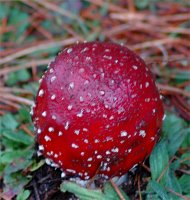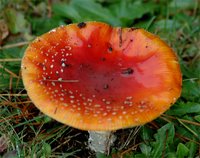 Robertson is home to some active Fairies - as evidenced by their little homes popping up everywhere, at present. I speak, of course of the famous, almost iconic, "Fairy Toadstools", also known boringly as the Fly Agaric, (Agaricus muscaria).
Robertson is home to some active Fairies - as evidenced by their little homes popping up everywhere, at present. I speak, of course of the famous, almost iconic, "Fairy Toadstools", also known boringly as the Fly Agaric, (Agaricus muscaria).
This Toadstool is the one so often drawn in kiddies stories of "Fairies in the Bottom of the Garden". Of course, I speak of English folk-lore, not the Australian Democrats (if they still exist).
Fairy Toadstool - fully "ripe".
 I like to think of these toadstools as indicative of how deeply programmed our cultural associations are, for although these Toadstools are instantly "familiar" to us, they are an introduced Fungus, which lives in what could loosely be called a symbiotic relationship with introduced Pine Trees, and a few other non-native trees. So, it is almost exclusively a fungus found around old settled areas on Australia, along the east coast. (In Tasmania, apparently, it is making the jump to associate with the native Antarctic Beech trees in the native forests).
I like to think of these toadstools as indicative of how deeply programmed our cultural associations are, for although these Toadstools are instantly "familiar" to us, they are an introduced Fungus, which lives in what could loosely be called a symbiotic relationship with introduced Pine Trees, and a few other non-native trees. So, it is almost exclusively a fungus found around old settled areas on Australia, along the east coast. (In Tasmania, apparently, it is making the jump to associate with the native Antarctic Beech trees in the native forests).
I remember first seeing these Toadstools growing in a neighbour's garden, in Canberra, about 15 years ago, and proudly showing them to Zoe. But already we both knew what they were (Fairy Toadstools). It is as if these old European myths are deeply programmed into our brains. Already, at first sight, they felt like long-lost friends. It is a weird sensation.
Fairy Toadstool - fully opened (concave cap)
 I remember previously having a similar sensation on my first visit to England, and travelling out to the English countryside. Everything looked "right" - it was green, the trees were the "right shape". And I was an Australian, through and through. And yet, culturally, I felt programmed to appreciate William Blake's "green and pleasant land".
I remember previously having a similar sensation on my first visit to England, and travelling out to the English countryside. Everything looked "right" - it was green, the trees were the "right shape". And I was an Australian, through and through. And yet, culturally, I felt programmed to appreciate William Blake's "green and pleasant land".
That familiar feeling of meeting an old friend is what I experience when I see these Fairy Toadstools.
The books say this Toadstool is poisonous. Other folk traditions talk of it having an hallucenogenic effect on Reindeer, in Northern European countries. Presumably other high-order mammals might experience similar sensations. Who really knows what a Reindeer feels, I ask you? Also there is a story that the "Whirling Dervishes" used this fungus in order to whip themselves into a frenzy before going off into their night-long dance trances (Wikipedia makes no mention of this rumour).
I shall settle for describing them as poisonous, and recommending that no part of them should be eaten.
I should clarify one term that I have used here - namely "Toadstool". I am indebted to my friend Roy Freere's talk yesterday to the Robertson Garden Club for explaining that the English tradition uses the word "Mushroom" for edible fungi, and "Toadstool" for poisonous fungi. The distinction is not only arbitrary, it is also dangerously inaccurate. There are closely related fungi, some of which are edible, and others of which are not only poisonous, but dangerously toxic. If you wish to eat "mushrooms", buy them from a shop. The correct term for all these organisms is "Fungi" .
I have used the term Toadstool for this particular fungus, because it is almost the archetypical Toadstool of literature. The specific name for this fungus is given in the first paragraph.

1 comment:
Denis, this is a truly beautiful post - magical. I am sure Enid Blyton would have appreciated it too. Thank you for the link to progressiveliving.com. This looks really worth an explore. De-light-ful!
Post a Comment